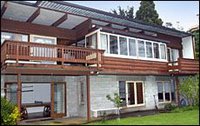 There's a political and architectural battle erupting in my very own street. From the Herald:
There's a political and architectural battle erupting in my very own street. From the Herald:Architects are rallying to protect a 1964 Epsom home designed by two members of Group Architects, who set the characteristics for the modern New Zealand house...Frankly, the house is nothing special. A box. Houses by Auckland's Group Architects were radical enough in New Zealand in the forties -- open plan living; raw materials with exposed structure and often creosote-stained cladding; simple mono-pitches-- but by the standards of today are little more than inelegant sheds. And if architecture by The Group is your thing, there's plenty of it about owned and preserved by people who like that sort of thing without the bossyboot busybodies enforcing protection on the owner of a house who may have no interest in such protection.
The family sold the largely original home last month at auction for just over $2 million to crown prosecutor Mark Woolford, who said he was considering his options for the property...
Auckland City Council heritage manager George Farrant has commissioned research on the house and received "hundreds of emails, mostly from the architectural community about the possible loss of this Group house" after it featured in the Weekend Herald's Heraldhomes section.
Mr Farrant expects to know in the next few days whether the house has enough points to be considered for heritage protection in the district plan.
Ivan Juriss, who is 81, said he was not bothered what the new owner planned to do with the house.
Perhaps if 'Auckland's architectural community' are really up in arms, they can club together with like-minded others and buy the place off Mr Woolford, ether in situ or for relocation. And if they don't value it enough to do do, it would suggest they don't value it quite as much as they say they do, and should cease imposing their own values on others.
Linked Article: Architects fight to preserve classic home
Heritage postcards celebrate local architecture
No comments:
Post a Comment